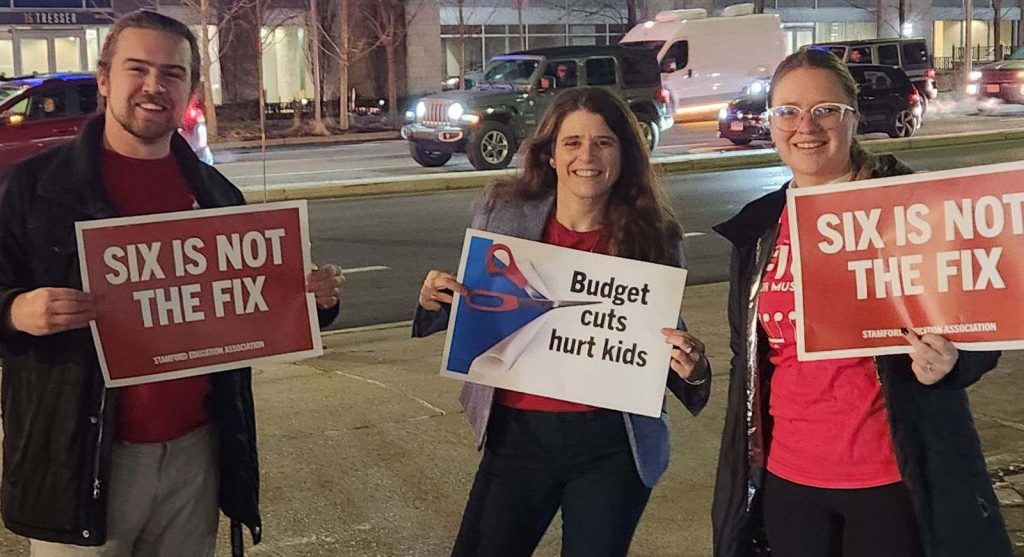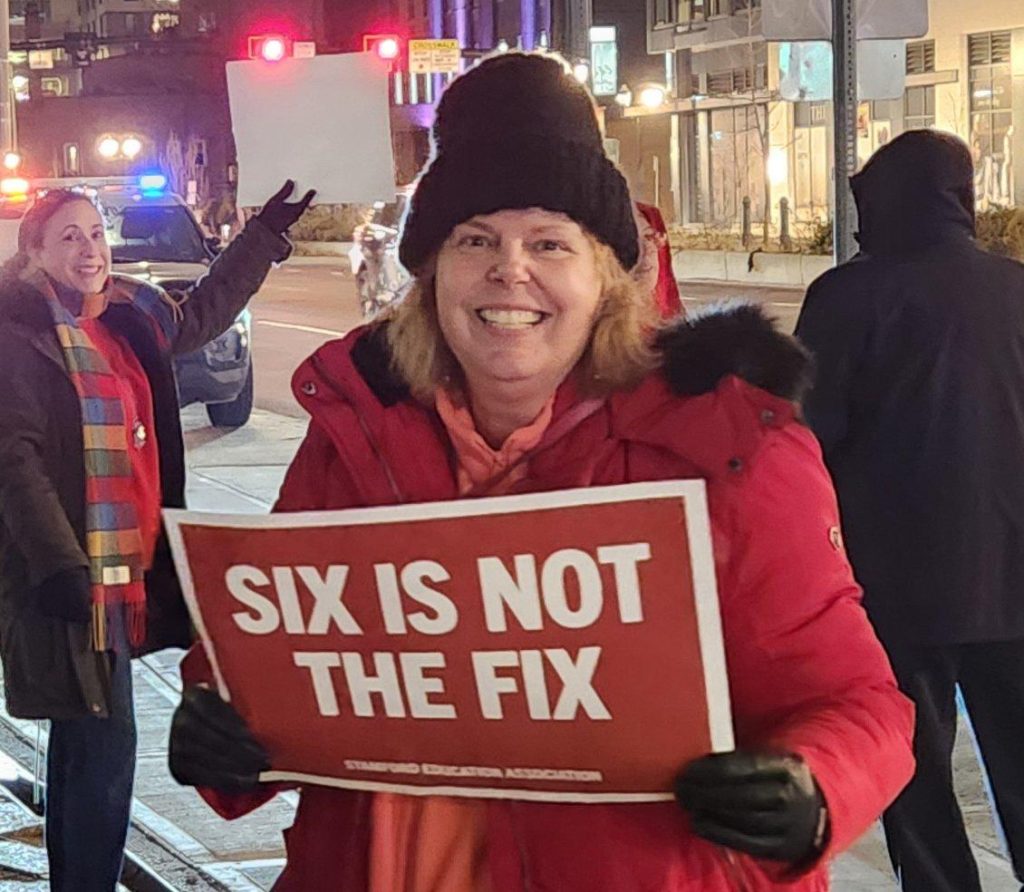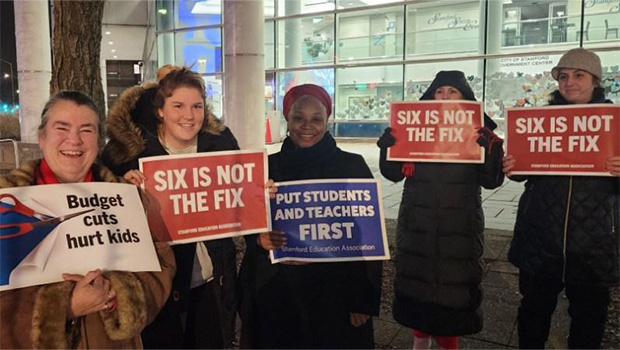“I stand with the teachers!”
That was how one resident began his plea to the Stamford Board of Education to support educators in the face of proposals that would make a difficult job even harder.
Teachers rallying outside the board meeting last night were joined by parents, students, and other community supporters urging the superintendent and board members to reject adding a sixth class to high school educators’ load.
The superintendent’s proposed schedule change would be devastating not only to educators—who would lose precious time outside of instructional hours needed to assist the hundreds of students they work with—but also, critically, to the students themselves.
“We have so many talented high school educators juggling work, family life, and students’ needs—a tough balancing act already—and adding a sixth class threatens to push those educators out of Stamford and into any number of neighboring districts that offer a manageable schedule,” said Stamford Education Association President John Corcoran. “The educators left behind will be drastically overworked, and their students underserved.”
He added, “On top of this, we’re working to stave off everything from budget cuts that would affect all of our schools, potential changes to the middle school schedule, and more. It can feel like an uphill battle, but we have so many supporters on our side, and we’re grateful that they’re taking time out of their own busy schedules to make their voices heard.”
Wrong move, wrong time
Dr. Christina Acocella, the parent of three high schoolers, said, “I’m concerned about the direction our district is taking. The proposal to add a sixth class to our teachers’ workload would create a situation, I’m afraid, that we won’t recover from. With class sizes now averaging 30 students, some teachers have 150 students; 180 is just unreasonable. Our kids lived through COVID and are still suffering academically and emotionally. They need extra support and personalized instruction from their teachers—which will become impossible if a sixth class is added.”
 She implored board members and the superintendent, “Please be open and ask teachers their opinions about how we can better serve our kids. Stamford is a wonderful, diverse, and cultural city, and if we want to continue to grow, we need to retain the teachers we have and not lose them to surrounding districts that pay more and ask for less. We need to expand special education, music, arts, and athletic programs in our schools, recognize how incredibly special our student population is, and trust our teachers to do what they do best. Let’s all care as much as they do.”
She implored board members and the superintendent, “Please be open and ask teachers their opinions about how we can better serve our kids. Stamford is a wonderful, diverse, and cultural city, and if we want to continue to grow, we need to retain the teachers we have and not lose them to surrounding districts that pay more and ask for less. We need to expand special education, music, arts, and athletic programs in our schools, recognize how incredibly special our student population is, and trust our teachers to do what they do best. Let’s all care as much as they do.”
Westhill High School science teacher and mother of two Carley Grant also spoke before the board. “My life outside of work is a whirlwind, and during the school year, I’m pulled in so many directions that when the last day of school rolls around, my daughters throw a party that very night.” The 18-year veteran educator explained, “Teaching at my current caseload, I’m drowning. I simply don’t have enough time during the school day to get it all done, so inevitably I take work home with me. My prep periods and the hours after school are spent planning lessons, setting up classroom activities, cleaning up, never-ending grading, countless committees, sitting with students for extra help and test corrections, and being a caring adult who listens to their worries and dreams. I pride myself on the fact that my classroom is a safe space for my students. But all of this takes time.”
The new schedule would create an added strain on teachers, said Grant, depriving them of the time needed to be effective in their roles. That possibility, she said, has left her heartbroken and considering a plan B.
Westhill High School junior Alana Gilbert offered a student’s perspective on the proposed change, making an impassioned plea to the superintendent to reconsider.
“If this proposal passes, there’s a high likelihood that teachers who are able to find work elsewhere will,” she suggested, adding, “Any school will be ecstatic to hire teachers with their experience. Remaining teachers would lose significant one-on-one time with their students. My peers and I have come to rely on these services, and there’s no way we can succeed without them.”
Plan B
CEA Vice President Joslyn DeLancey spoke not only as a public school teacher in neighboring Darien but also as a Stamford resident and voter.
 “What are we doing to Stamford students when we put our teachers in a position where they have to question whether they have tenable working conditions in Stamford Public Schools?” she asked. “We need to be building personal relationships with our students, and adding a sixth class puts us in a position where we cannot find the time. How we build our budget shows how we invest in our teachers and students.”
“What are we doing to Stamford students when we put our teachers in a position where they have to question whether they have tenable working conditions in Stamford Public Schools?” she asked. “We need to be building personal relationships with our students, and adding a sixth class puts us in a position where we cannot find the time. How we build our budget shows how we invest in our teachers and students.”
Pointing out that Stamford’s superintendent is one of Connecticut’s highest paid, DeLancey reminded the board that the Stamford’s per-pupil spending is not the highest in the state.
“How are we prioritizing?” she asked. “If we are looking to cut teachers here in Stamford, how are we competing with the best school districts in Connecticut? I work for one, and I know we should be prioritizing building a dynamic, creative, impactful school system.”
“I cannot figure out how a district that is already struggling could possibly think adding a sixth class is a good thing,” said a Stamford Parent Teacher Council member who missed a prom committee planning meeting to come out and speak up for her child’s teachers. “Teachers are professionals, and you’ve heard from them about the burdens this will bring. We are a high-needs district, and that calls for more resources and time with students. There is one proposal after another that seems to come at our teachers, and everyone should recognize that they will go to other districts at time when there is competition and a teacher shortage.”
While the board has said the decision regarding a sixth class rests solely with the superintendent, SEA members hope that continuing to hear the deep concerns of educators, parents, and other stakeholders will persuade a rethinking of the proposal.
“Our goal is to make sure that decisions like this, which impact our students and the quality of their education, are made with teachers’ input,” says Corcoran. “They’re the ones who know firsthand what those impacts will be.”







